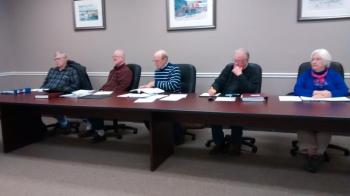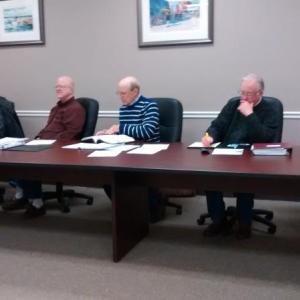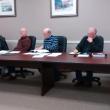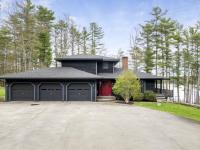Potential Romar buyer challenges code use interpretation
The interpretation of principal property uses according to current land use codes was the sole topic of an Oct. 26 meeting between the Boothbay Harbor Planning Board, the Knickerbocker Group, and Boothbay Harbor Code Enforcement Officer Geoff Smith. The town, the board, town attorney Mary Costigan, the Department of Environmental Protection, and the Maine Municipal Association (MMA) have determined that the Romar bowling alley property, currently under a purchase-and-sale agreement, has four principal uses, while the Knickerbocker Group, representing the potential buyer, Dr. Rahul Anand (8 Wharf St. LLC), believes there are six.
Built in 1928, the structure was renovated by Charlie Rowe and Leslie Marr in 1945. In 1946, Romar, with the name a combination of Rowe and Marr, opened as a bowling alley, which was its principal use. Years passed, and a commercial parking lot, an art gallery, and a marina were also designated as principal uses. Accessory uses, those uses subordinate to principal ones, included a cafe, office space, and an arcade.
Knickerbocker is arguing that the cafe and office space operated independently of the bowling alley, and should be considered principal uses. Architectural designer Randy Smith of Knickerbocker said during the meeting, “People walked into the cafe to buy food, and walked out without using the bowling alley. And the property management office had its own entrance and sidewalk.”
“I will take your statement that people went to the building for the food,” said Planning Board Vice Chairman William Hamblen. “But if you pay the same guy who took care of you when you wanted to bowl, it's hard for me to separate it. It's still one use.”
Smith used a schematic drawing to demonstrate his client’s intentions. “Plans include added green space, continued public access to the by way sidewalk, removal of structure currently over the water, and lateral expansion. The building would consist of two floors with commercial use on the first floor and residential use on the second,” he explained. “The marina would remain unchanged. But until we have a determination regarding the number of allowed uses, we can’t be specific to the plans as the use determination is crucial to the design of the structure.”
According to town code, only so many principal uses are allowed per property. Geoff Smith said Romar’s four established principal uses exceed code, but are allowed. “The land use code states that each principal use ... requires a minimum amount of land area, which varies based on what zoning district you are in, and whether public water and sewer are available. For the purpose of this discussion, the land use code requires 10,000 square feet of land per ... use. The number of uses exceeds the number allowed by the land use code in relation to the required ... acreage, but as the uses already exist, the property is considered legally non-conforming, and those uses may continue, or other legally allowed uses may take their place, as long as the total amount of principal uses does not exceed four.”
This was re-enforced recently by an Oct. 24 letter Geoff Smith received from MMA Legal Services representative Michael L. Stultz, who wrote, “There are only four uses currently existing. These are: the parking facilities, the marina, the bowling alley, and the art gallery. To classify the eating area, arcade, and office space as a restaurant, recreation facility and professional use, respectively, is to mischaracterize their true nature. I find nothing within the limits of (local) code to accommodate the understanding of the number of existing uses.”
But Randy Smith believes his client is right regarding his claim. “The basis for this determination is through testimony and documentation provided by both the Rowe sisters (daughters of former owner Charlie Rowe) as well as members of the community who frequented the property while it was in operation.”
Before the next board meeting on Nov. 9, Knickerbocker planned to submit additional documentation in time for parties to review and comment on it. Randy Smith said he is grateful the project has the support of downtown businesses and is thankful for the board’s willingness to continue the discussion. He said his client is under a purchase-and-sale agreement, with the due diligence period ending shortly after the Nov. 9 meeting.
Whatever the outcome, the project has raised issues concerning future construction in the downtown district. During a post-meeting phone interview, Hamblen said, “Romar is one of the largest commercial properties in the district. The planning board will be checking the codes to see if they need to be modified so this won’t be a sticking point in the future.”
Geoff Smith said any modifications to codes will take time and discussion. “If, as a result of these discussions, there is a feeling by the municipality and the public that further amendments to the land use code would be beneficial, those amendments would be discussed, drafted, heard at public meetings, and ultimately voted on at town meeting.”
The Nov. 9 meeting starts at 6 p.m. at the Boothbay Harbor town office.
Event Date
Address
United States



























